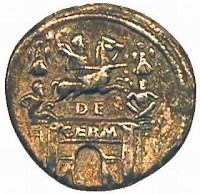Rome, Arch of Drusus
Q1107952Arch of Drusus: name of a monument on the Via Appia.

Born 38 BCE, very soon after his mother Livia had divorced Tiberius Claudius Nero and married Octavian (the future emperor Augustus), the Roman prince Drusus was widely believed to be the latter's son. Octavian adopted his stepson when the boy was six years old and gave him an excellent education. In 15 BCE, the young man commanded an army against the Raetians, which were defeated. After 12, he was responsible for the Roman conquest of Germania, conquered the valleys of the rivers Main and Lippe, crossed the Weser, and reached the river Elbe. In the winter of 11/10, he celebrated a minor triumph (an ovatio). In 9, he died after a fall from his horse. The conqueror of Germania was twenty-nine years old.
The monument now known as Arch of Drusus has nothing to do with Drusus. In fact, it was built more than two centuries after his death at the point where the Aqua Antoniana aqueduct, which supplied the Baths of Caracalla, crossed the Via Appia. As was usual, the arch on which the water was carried across the road, was decorated (cf. the Porta Maggiore).
The remains of the real Arch of Drusus, which was erected by the Senate,note may have been found near this part of the aqueduct, which is close to the Porta Sebastiano. A coin that commemorates Drusus' victories in Germania. struck by his son Claudius, shows the real monument. On top of the arch is a statue of Drusus on horseback, flanked by two trophies and sitting captives.